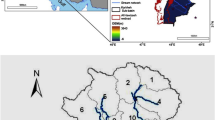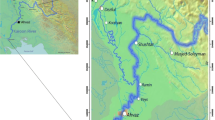Abstract
The present study examines the suitability of water (surface and bottom) of the Damodar River and its tributaries for irrigation purposes. Irrigation water quality index (IWQI) and indices related to irrigation hazards (salinity, alkalinity, sodicity, and permeability) were measured at 14 stations located around the confluence of the tributaries with the trunk stream to assess the point-specific as well as spatial variations of river water quality and its degree of suitability to irrigation. The degree of salinity hazard (both the surface and bottom water) ranges from low to medium along with a low degree of sodium hazard for both the surface and bottom water. Doneen’s permeability diagram has found 7.14% of the surface and 14.29% of the bottom water samples unsuitable for irrigation. Moreover, the alkali hazard indicates that all of the water samples (both the surface and bottom water) are suitable for irrigation due to the lesser concentration of sodium in the river water. Furthermore, the IWQI ranges from 37.83 to 47.01 on the surface and 42.1 to 53.02 in the bottom water samples of the river. Thus, the poor water quality is mainly driven by the mixing of polluted water from the urban-industrial complex in the Damodar region. The spatial variation in downstream river water quality and the point-specific assessment of the river water quality around the confluences contributes to locating the potential pollutant bearing segments within the watershed. The study bears a valuable understanding of sustainable irrigation development within a watershed.






Similar content being viewed by others
References
Al-Hadithi, M., Hasan, K., Algburi, A., & Al-Paruany, K. (2019). Groundwater quality assessment using irrigation water quality index and GIS in Baghdad, Iraq. Jordan Journal of Earth and Environmental Sciences, 10(1), 15–20.
Banerjee, K., Banerjee, R., Sen, A., Mukhopadhyay, S., Ach, S., Singh, D., & Mandal, B. (2003). Damodar river pollution and health hazards. Journal of the Indian Medical Association, 101(2), 104–106.
Batarseh, M., Imreizeeq, E., Tilev, S., Al Alaween, M., Suleiman, W., Al Remeithi, A. M., & Al Alawneh, M. (2021). Assessment of groundwater quality for irrigation in the arid regions using irrigation water quality index (IWQI) and GIS-Zoning maps: Case study from Abu Dhabi Emirate, UAE. Groundwater for Sustainable Development, 14, 100611. https://doi.org/10.1016/j.gsd.2021.100611
Bhattacharyya, K. (2011). The Lower Damodar River, India: Understanding the human role in changing fluvial environment. Springer.
Chen, J., He, D., & Cui, S. (2003). The response of river water quality and quantity to the development of irrigated agriculture in the last 4 decades in the Yellow River Basin, China. Water Resources Research. https://doi.org/10.1029/2001WR001234
CIFRI (1998). The River Damodar and Its Environment. Indian Council of Agricultural Research, Barrackpore, Bull. No. 73. http://www.cifri.res.in/Bulletins/Bulletin%20No.79.pdf. Accessed 15 Dec 2021.
De, A. K., Sen, A. K., & Modak, A. P. (1980). Some industrial effluents in Durgapur and their impact on the Damodar River. Environmental International, 4(2), 101–105.
Deepika, S. S., & Singh, S. K. (2015). Water quality index assessment of Bhalswa Lake, New Delhi. International Journal of Advanced Research, 3(5), 1052–1059.
Dhembare, A. J. (2012). Assessment of water quality indices for irrigation of Dynaneshwar dam water, Ahmednagar, Maharashtra, India. Archives of Applied Science Research, 4(1), 348–352.
Doneen, L. D. (1964). Water quality for Agriculture (p. 48). University of California.
Dutta, T., Chaudhuri, H., & Maji, C. (2021). Water Pollution in Damodar River Basin—A Statistical Analysis. In Advances in Water Resources Management for Sustainable Use (pp. 187–215). Springer, Singapore. https://doi.org/10.1007/978-981-33-6412-7_15
DVC. (2016). Annual Report 2015–16. https://www.dvc.gov.in/dvcwebsite_new1/downloads/annual-report/. Accessed 9 Aug 2021.
Eaton, F. M. (1950). Significance of carbonates in irrigation waters. Soil Science, 69(2), 123–134.
Falowo, O. O., Akindureni, Y., & Ojo, O. (2017). Irrigation and drinking water quality index determination for groundwater quality evaluation in Akoko Northwest and Northeast Areas of Ondo State, Southwestern Nigeria. American Journal of Water Science and Engineering, 3(5), 50–60.
Gupta, S. K., & Gupta, I. C. (2015). Management of saline & waste water in agriculture (p. 60). Scientific Publishers, India.
Ghosh, S., & Guchhait, S. K. (2016). Dam-induced changes in flood hydrology and flood frequency of tropical river: A study in Damodar River of West Bengal, India. Arabian Journal of Geosciences, 9, 90. https://doi.org/10.1007/s12517-015-2046-6
Ghosh, S., Hoque, M. M., Saha, U. D., & Islam, A. (2022). Assessment of dam-induced changes in ecogeomorphological behaviour and fluvial functionality in the Damodar River, West Bengal. India. AQUA—Water Infrastructure, Ecosystems and Society, 71(6), 722–750. https://doi.org/10.2166/aqua.2022.003.
Haldar, D., Halder, S., Das, P., & Halder, G. (2016). Assessment of water quality of Damodar River in South Bengal region of India by Canadian Council of Ministers of Environment (CCME) Water Quality Index: A case study. Desalination and Water Treatment, 57(8), 3489–3502. https://doi.org/10.1080/19443994.2014.987168
Hoque, M., Islam, A., & Ghosh, S. (2022). Environmental flow in the context of dams and development with special reference to the Damodar Valley Project, India: a review. Sustainable Water Resources Management, 8(3), 1–27. https://doi.org/10.1007/s40899-022-00646-9.
Kelley, W. P. (1963). Use of saline irrigation water. Soil Science, 95(6), 385–391.
Knighton, A. D. (1998). Fluvial forms and processes: A new perspective. Edward Arnold.
Majumder, M., Roy, P., & Mazumdar, A. (2010). An introduction and current trends of Damodar and Rupnarayan River network. In Impact of climate change on natural resource management (pp. 461–480). Springer. https://doi.org/10.1007/978-90-481-3581-3_25.
Meireles, A. C. M., Andrade, E. M. D., Chaves, L. C. G., Frischkorn, H., & Crisostomo, L. A. (2010). A new proposal of the classification of irrigation water. Revista Ciência Agronômica, 41, 349–357.
Mahammad, S., & Islam, A. (2021a). Identification of palaeochannels using optical images and radar data: A study of the Damodar Fan Delta, India. Arabian Journal of Geosciences, 14(17), 1–22. https://doi.org/10.1007/s12517-021-07818-5.
Mahammad, S., & Islam, A. (2021b). Evaluating the groundwater quality of Damodar Fan Delta (India) using fuzzy-AHP MCDM technique. Applied Water Science, 11(7), 1–17. https://doi.org/10.1007/s13201-021-01408-2.
Mahammad, S., Islam, A., & Shit, P. K. (2022). Geospatial assessment of groundwater quality using entropy-based irrigation water quality index and heavy metal pollution indices. Environmental Science and Pollution Research. https://doi.org/10.1007/s11356-022-20665-5.
Patra, S. (2008). Pollution profile of Damodar River in a particular stretch. Unpublished Report of Master of Technology in Conservation of Rivers and Lakes, Alternate Hydro Energy Centre, Indian Institute of Technology Roorkee.
Raghunath, H. M. (1987). Groundwater: hydrogeology, groundwater survey and pumping tests, rural water supply, and irrigation systems. New Age International.
Raymond, P. A., Oh, N. H., Turner, R. E., & Broussard, W. (2008). Anthropogenically enhanced fluxes of water and carbon from the Mississippi River. Nature, 451(7177), 449–452. https://doi.org/10.1038/nature06505
Richards, L. A. (1954). Diagnosis and improvement of saline and alkali soils. USDA hand book. https://www.ars.usda.gov/ARSUserFiles/20360500/hb60_pdf/hb60complete.pdf . Accessed 12 Dec 2021.
Sarkar, B., & Islam, A. (2019). Assessing the suitability of water for irrigation using major physical parameters and ion chemistry: A study of the Churni River, India. Arabian Journal of Geosciences, 12(20), 1–16. https://doi.org/10.1007/s12517-019-4827-9
Sarkar, B., & Islam, A. (2021). Assessing the suitability of groundwater for irrigation in the light of natural forcing and anthropogenic influx: a study in the Gangetic West Bengal. India. Environmental Earth Sciences, 80(24), 1–19. https://doi.org/10.1007/s12665-021-10087-w.
Sarkar, B., Islam, A., & Majumder, A. (2021). Seawater intrusion into groundwater and its impact on irrigation and agriculture: Evidence from the coastal region of West Bengal. India. Regional Studies in Marine Science, 44, 101751. https://doi.org/10.1016/j.rsma.2021.101751.
Sarkar, B., Islam, A., Das, B. C., & Nandy, S. (2022). Corrosion and scaling potential of groundwater in Quaternary aquifers of Bengal Basin, India. Arabian Journal of Geosciences, 15(12), 1–21. https://doi.org/10.1007/s12517-022-10415-9.
Singh, A., Deo, B., & Singh, S. P. (2014). Risk analysis on the use of Damodar river water for drinking purposes. International Journal of Current Engineering and Technology, 4(1), 405–410.
Spandana, M. P., Suresh, K. R., & Prathima, B. (2013). Developing an irrigation water quality index for the Vrishabavathi command area. International Journal of Engineering Research & Technology, 2, 821–830.
Tiri, A., Belkhiri, L., Asma, M., & Mouni, L. (2020). Suitability and assessment of surface water for irrigation purpose. Water Chemistry. https://doi.org/10.5772/intechopen.86651
Todd, D. K. (1960). Saltwater intrusion of coastal aquifers in the United States. Subterranean Water, 52, 452–461. https://doi.org/10.1016/j.ecolecon.2009.04.019
Wikipedia. (2021). Damodar River. https://en.wikipedia.org/wiki/DamodarRiver. Accessed 15 Aug 2021.
Yıldız, S., & Karakuş, C. B. (2020). Estimation of irrigation water quality index with development of an optimum model: A case study. Environment, Development, and Sustainability, 22(5), 4771–4786. https://doi.org/10.1007/s10668-019-00405-5
Acknowledgements
This study was funded by the University Grants Commission (UGC) Junior Research Fellowship (JRF), Govt. of India vide letter number 3286/(OBC)(NET-JAN 2017) dated 1st September 2017 to carry out the Ph.D. work of the first author (Md. Mofizul Hoque) of this paper. Moreover, National Test House, Kolkata, India is duly acknowledged for extending the kind cooperation for testing the water samples at a subsidized rate.
Author information
Authors and Affiliations
Corresponding author
Ethics declarations
Conflict of interest
The authors declare that they have no conflict of interest.
Supplementary Information
Below is the link to the electronic supplementary material.
Rights and permissions
About this article
Cite this article
Hoque, M.M., Islam, A., Sarkar, B. et al. Assessing the surface and bottom river water quality for irrigation: a study of Damodar River, India. Int J Energ Water Res (2022). https://doi.org/10.1007/s42108-022-00206-z
Received:
Accepted:
Published:
DOI: https://doi.org/10.1007/s42108-022-00206-z




